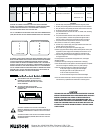
1.) CD/Tape Input - this 1/4 3 conductor jack will allow you to plug in a CD player, tape or any other source to
practice along with. It sums the left and right signals into a mono signal and passes it through to the amplifier
section. To control the volume of the source, adjust the output volume of the device. We suggest you turn the
volume all the way down then plug in and adjust the volume according to your taste.
2.) Guitar Input - this is a 1/4 2 conductor input jack for plugging in your instrument. It is intended for bass guitar
or Hi-Z microphones but will accept other instruments as well.
3.) Volume Level - this control is the output volume control for the bass guitar input. Slowly increase the control
to increase the volume. If you are using a bass guitar with an on-board preamp, set its level for a mid position
before increasing this control otherwise distortion may occur.
4.) Notch - this control is a dramatic cut filter. It is notched at a rate of -15db. The width of the notch is set at
one octave and can be swept from 45 Hz to 1KHz. It will create a very precise subtraction of undesirable overtones
or allow you to fine tune your tone settings.
5.) Low - this control is the bass control. It is active and set to boost or cut frequencies at 60 Hz. This will effect
the low frequency signals. Turning it fully clockwise, the signal is boosted 15 db. Turning it counterclockwise,
the low will be rolled off -15db. Especially good for making low output, thin toned bass guitars sound fuller.
6.) Lo Mid - this control is the Low Midrange control. It is active and set to boost or cut frequencies at 250 Hz.
This will effect the mid-low frequency signals. Turning it fully clockwise, the signal is boosted 10 db. Turning it
counterclockwise, the low-mids will be rolled off -10db. Especially good for cleaning up muddy bass guitar
overtones.
7.) Hi Mid - this control is the High Midrange control. It is active and set to boost or cut frequencies at 1.5KHz.
This will effect the mid-high frequency signals. Turning it fully clockwise, the signal is boosted 10 db. Turning it
counterclockwise, the low-mids will be rolled off -10db. Increasing this will add punch to a bass guitars sound.
8.) High - this is the high frequency control. It is active and set to boost or cut frequencies at 8KHz. This will
effect the high frequency signals. Turning it fully clockwise, the signal is boosted 15 db. Turning it counterclockwise,
the highs will be rolled off -15db. This will add or subtract the high end attack of slapping style sounds or pick
attack and clarity.
9.) Headphone Jack - this is a 1/4 3 conductor jack for plugging headphones. It will sum the signal and put
the sound in both ears, thereby creating a pseudo-stereo sound. Volume will be determined by the volume control
on the channel you are on. It will disconnect the internal speaker when plugged into. This will allow quiet practicing.
10.) Jewel Light - this jewel light lets you know that the amplifier is on.
11.) Power - this switch turns on and off the AC power to the amp.
Back Panel - (not pictured)
Speaker Out - this is a 2 conductor 1/4 speaker output jack. This will disconnect the internal speaker and allow
an external speaker cabinet to be employed. Rating is 8 ohms.
Line Output - this is a 2 conductor 1/4 line output jack. This will allow an external amplifier or mixing board to
be supplied with the signal from this amp. This is output is attenuated and comes from the power amp signal.
Effects Loop - these are 2- 2 conductor 1/4 jacks. This will allow an external effects device or equalizer to be
patched back in before the power amp section in this amp. One is send and the other is return.
KBA30
10
11
4
7
68
12
5
3
9






